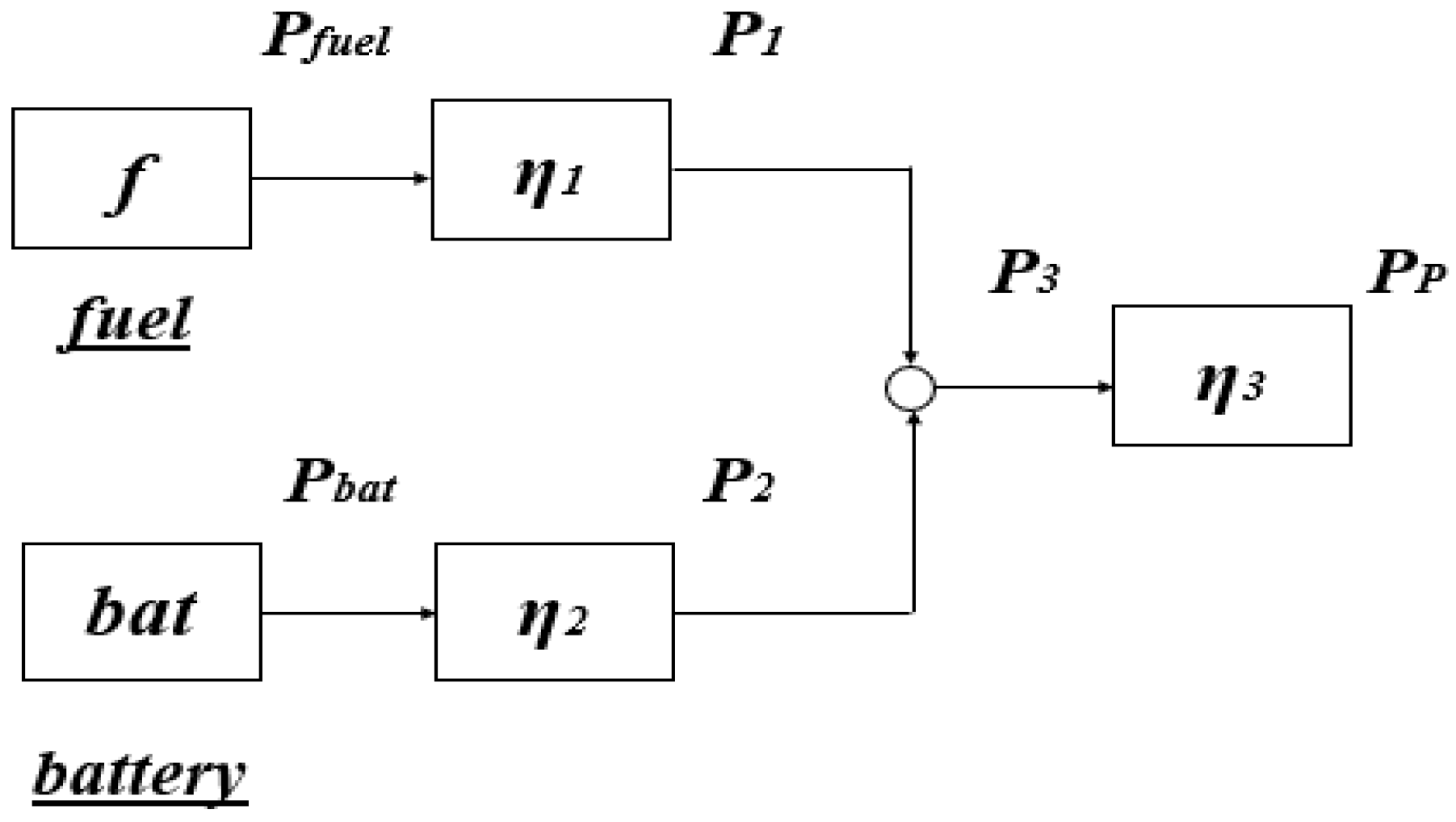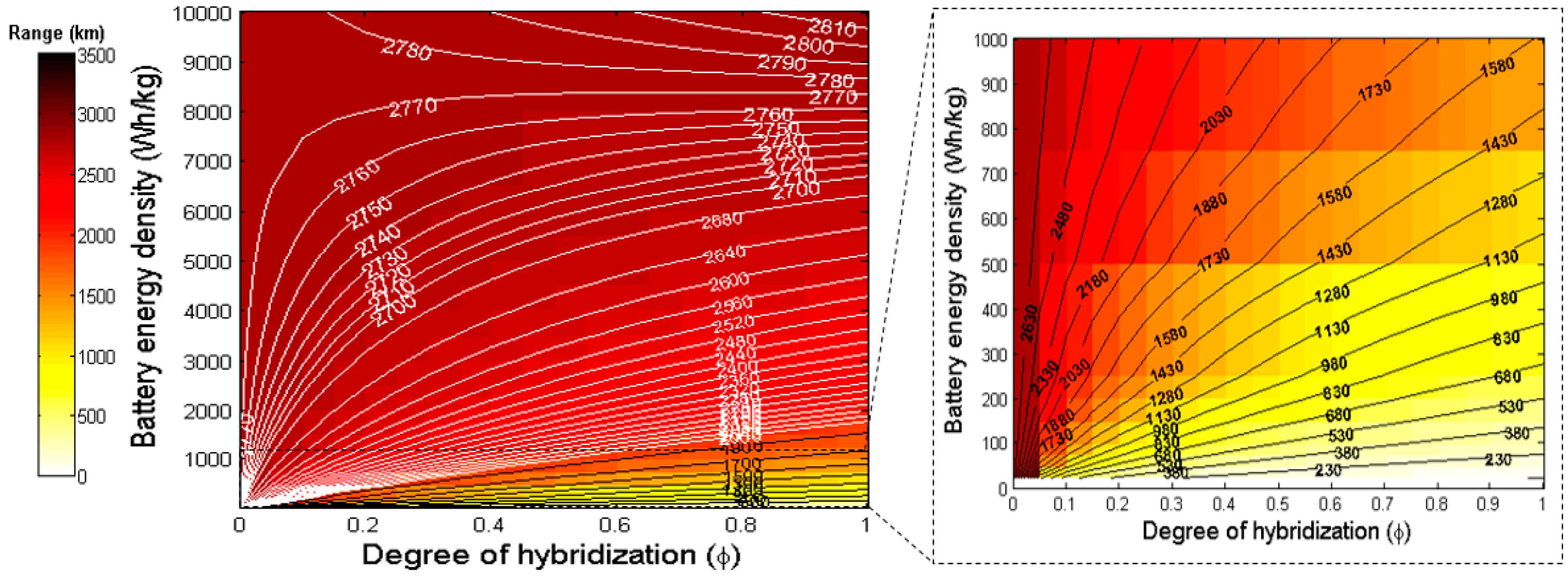On the Range Equation for Hybrid-Electric Aircraft
Abstract
:1. Introduction
2. Hybrid-Electric Aircraft Configuration
3. An Efficiency-Based Definition of the Degree of Hybridization (φ)
4. Derivation of Modified Hybrid-Electric Range Equation
- = 1, to check if the new range Equation (40) reduces back to the range equation in [11];
- φ = 0, to check if the new range Equation (40) reduces back to the classical Brequet equation for a fully-fueled aircraft;
- φ = 1, to check if the new range Equation (40) reduces back to the range equation for a fully-electric aircraft.
5. Case Study
- A parallel hybrid-electric configuration provides a slightly higher range than a series hybrid-electric configuration. This is largely due to the fact that a series hybrid electric has a double efficiency penalty on the electric powertrain, one on the generator and one on the motor. Conversely, the series hybrid only requires the motor powered by the battery and therefore does not suffer from this penalty. The difference between the two configurations increases with an increased degree of hybridization. In order to highlight the differences between the two configurations, some point data were selected and are listed in Table 3 below.
- For both parallel and series-hybrid configurations, with a constant battery energy density, the range decreases with an increase in the degree of hybridization. This is observed to happen until a threshold in battery energy density is reached. Beyond this threshold, the aircraft range increases with the degree of hybridization. This follows the logical sequence that below the threshold, the battery energy density is still too low compared with fuel energy density; with an increase in the degree of hybridization, the weight of batteries would increase, therefore, the resultant range decreases. However, as the product of the battery energy density and powertrain efficiencies become comparable to the product of the fuel energy density and combustion efficiency, the range of the aircraft increases with a higher degree of hybridization towards the full electric aircraft.
- This threshold value is the point at which the aircraft range becomes independent of the degree of hybridization. In Parallel hybrid-electric, this threshold is at 9300 Wh/kg, while in series hybrid-electric configurations, this threshold is at 8700 Wh/kg. The larger value for a parallel hybrid-electric is also logical, as this configuration has a stronger dependence on the battery. The actual values change depending on the aircraft parameters chosen in Table 2. However, in our work we specifically choose the same values used in earlier research [11] to show that there is now a strong departure from the earlier published research, which showed a threshold of 500 Wh/kg. This is a direct effect of the definition of the efficiency-based degree of hybridization, which now also takes into consideration the efficiencies of the fuel and electric powertrains. Due to the change in threshold from [11], the differences were observed in the results of the range as well.
- The significance of the much larger threshold values becomes apparent when taken into context. Battery energy density doubles approximately every 23 years [5]. Considering that the current state-of-the-art battery technology has an energy density of 228 Wh/kg, the old definition makes a hybrid aircraft with properties specified in Table 2 achievable within the next two decades. However, when considering all efficiencies, this threshold lies beyond the theoretical limits of battery energy densities (228 Wh/kg).
- Despite the significant progress in battery technology required to enable electric flight, hybrid electric aircraft may still be applied to smaller aircraft which do not exceed the 1000 km range. An example of this is in the use of regional aircraft. Even a low degree of hybridization, when applied to a large fleet, would offer a significant reduction in fuel consumption and emissions. Therefore, the authors feel that this hybrid-electric configuration has the ability to bridge the gap until better fuel alternatives are found.
6. Conclusions
Author Contributions
Funding
Conflicts of Interest
Nomenclature
| cL | Coefficient of Lift |
| cD | Coefficient of Drag |
| D | Drag [N] |
| e | Specific Energy [J/kg] |
| E | Energy [J] |
| g | Gravitational acceleration [m/s2] |
| L | Lift [N] |
| P | Power [W] |
| R | Range [m] |
| S | Planform area [m2] |
| t | Time [s] |
| T | Thrust [N] |
| v | Velocity [m/s] |
| W | Weight [N] |
| γ | Flight path angle [rad] |
| η | Efficiency |
| φ | Degree of hybridization |
| ρ | Density |
| Subscripts | |
| 1,2,3 | Powertrain branch indices |
| bat | Battery |
| eg | Electrical generator |
| em | Electrical motor |
| end | End of mission segment |
| f | Fuel |
| gt | Gas turbine |
| gb | Gearbox |
| OE | Operating Empty |
| p | Propeller |
| PL | Payload |
| start | Start of mission segment |
| tot | Total |
References
- Airbus Global Market Forecast (GMF). Available online: https://www.airbus.com/en/products-services/commercial-aircraft/market/global-market-forecast (accessed on 15 July 2023).
- European Commission. Flightpath 2050 CARE2050. Flightpath 2050, Europe’s Vision for Aviation. Available online: https://ec.europa.eu/transport/sites/transport/files/modes/air/doc/flightpath2050.pdf (accessed on 2 December 2022).
- Hoelzen, J.; Silberhorn, D.; Zill, T.; Bensmann, B.; Rauschenbach, R.H. Hydrogen-Powered Aviation and Its Reliance on Green Hydrogen Infrastructure—Review and Research Gaps; Elsevier: Amsterdam, The Netherlands, 2022; Volume 47, No. 5, pp. 3108–3130. [Google Scholar] [CrossRef]
- Schwab, A.; Thomas, A.; Bennett, J.; Robertson, E.; Cary, S. Electrification of Aircraft: Challenges, Barriers, and Potential Impacts; NREL/TP-6A20-80220; National Renewable Energy Laboratory (NREL): Golden, CO, USA, 2021. [Google Scholar]
- Zhang, L.; Butler, T.L.; Yang, B. Recent Trends, Opportunities and Challenges of Sustainable Aviation Fuel. In Green Energy to Sustainability: Strategies for Global Industries, 1st ed.; Wiley: New York, NY, USA, 2020. [Google Scholar]
- Viswanathan, V.; Epstein, A.H.; Chiang, Y.; Takeuchi, E.; Bradley, M.; Langford, J.; Winter, M. The challenges and opportunities of battery-powered flight. Nat. Perspect. 2022, 601, 519–525. [Google Scholar] [CrossRef] [PubMed]
- International Food Policy Research Institute (IFPRI). F00d Versus Fuel v2.0: Biofuel Policies and the Current Food Crisis. Available online: https://www.ifpri.org/blog/food-versus-fuel-v20-biofuel-policies-and-current-food-crisis (accessed on 16 July 2023).
- Rossi, N.; Trainelli, L.; Riboldi, C.E.D.; Rolando, A. Conceptual Design of Hybrid-Electric Aircraft. Politech. Di Milano 2018, 2016–2017. Available online: https://www.politesi.polimi.it/bitstream/10589/139491/3/2018_04_Rossi.pdf (accessed on 16 July 2023).
- Wheeler, P.; Sirimanna, A.S.; Bozhko, S.; Haran, K.S. Electric/Hybrid-Electric Aircraft Propulsion Systems. Proc. IEEE 2021, 109, 1115–1127. [Google Scholar] [CrossRef]
- Marciello, V.; Ruocco, M.; Nicolosi, F.; Stasio, M.D. Markey Analysis, TLARS selection and preliminary design investigations for a regional hybrid-electric aircraft. In Proceedings of the 33rd Congress of the International Council of the Aeronautical Sciences (ICAS), Stockholm, Sweden, 4–9 September 2022. [Google Scholar]
- Vries, R.D.; Hoogreef, M.F.M.; Vos, R. Range Equation for Hybrid-Electric Aircraft with Constant Power Split. J. Aircr. 2020, 57, 552–557. [Google Scholar] [CrossRef]
- Raymer, D.P. Aircraft Design: A Conceptual Approach; AIAA Education Series; AIAA: Reston, VA, USA, 2002. [Google Scholar] [CrossRef]
- Hepperle, M. Electric Flight—Potential and Limitations. NATO Report STO-MP-AVT-209. 2012. Available online: https://elib.dlr.de/78726/1/MP-AVT-209-09.pdf. (accessed on 16 July 2023).
- Ravishankar, R.; Chakravarthy, S.R. Range Equation for a Series Hybrid Electric Aircraft. In Proceedings of the 2018 Aviation Technology, Integration, and Operations Conference, Atlanta, GA, USA, 25–29 June 2018. [Google Scholar] [CrossRef]
- Elmousadik, S.; Ridard, V.; Sécrieru, N.; Joksimovic, A.; Maury, C.; Carbonneau, X. New Preliminary Sizing Methodology for a Commuter Airplane with Hybrid-Electric Distributed Propulsion. In Proceedings of the Advanced Aircraft Efficiency in a Global Air Transport System (AEGATS 18), Toulouse, France, 23–25 October 2018. [Google Scholar]
- Rohacs, J.; Rohacs, D. Energy coefficients for comparison of aircraft supported by different propulsion systems. Energy 2019, 191, 1–11. [Google Scholar] [CrossRef]
- Marwa, M.; Martin, S.M.; Martos, B.C.; Anderson, R.P. Analytic and Numeric Forms for the Performance of Propeller-Powered Electric and Hybrid Aircraft. In Proceedings of the 55th AIAA Aerospace Sciences Meeting, Grapevine, TX, USA, 9–13 January 2017. [Google Scholar] [CrossRef]
- Hartmann, J.; Strack, M.; Nagel, B. Conceptual Assessment of Different Hybrid Electric Air Vehicle Options for a Commuter with 19 Passengers. In Proceedings of the 2018 AIAA Aerospace Sciences Meeting, Kissimmee, FL, USA, 8–12 January 2018. [Google Scholar] [CrossRef]
- Xie, Y.; Savvarisal, A.; Tsourdos, A.; Zhang, D.; Gu, L. Review of hybrid electric powered aircraft, its conceptual design and energy management methodologies. Chin. J. Aeronaut. 2020, 34, 432–450. [Google Scholar] [CrossRef]
- Finger, D.F.; Braun, C.; Bil, C. Comparative Assessment of Parallel-Hybrid-Electric Propulsion Systems for Four Different Aircraft. J. Aircr. 2020, 57, 843–853. [Google Scholar] [CrossRef]
- Zamboni, J.; Vos, R.; Emeneth, M.; Schneegans, A. A Method for the Conceptual Design of Hybrid Electric Aircraft. In Proceedings of the AIAA SciTech 2019 Forum, San Diego, CA, USA, 7–11 January 2019. [Google Scholar] [CrossRef] [Green Version]
- Bai, M.; Yang, W.; Li, J.; Kosuda, M.; Fozo, L.; Kelemen, M. Sizing methodology and Energy Management of an Air-Ground Aircraft with Turbo-Electric Hybrid Propulsion System. Aerospace 2022, 9, 764. [Google Scholar] [CrossRef]
- Taylor, A.E. L’Hospital’s Rule. Am. Math. Mon. 1952, 59, 20–24. [Google Scholar] [CrossRef]





| Simplified Representation | Mechanical-Node Architecture (or Parallel Configuration) | Electrical-Node Architecture (or Series Configuration) |
|---|---|---|
| 1 | ||
| Variable | Value |
|---|---|
| Empty weight (WOE [N]) | 50,000 |
| Payload weight (WPL [N]) | 20,000 |
| Total input energy (Eo,tot [GJ]) | 25 |
| Lift-to-drag ratio (L/D ratio) | 12 |
| Gas turbine efficiency (ηgt) | 0.35 |
| Electric motor efficiency (ηem) | 0.95 |
| Electric generator efficiency (ηeg) | 0.98 |
| Propulsive efficiency (ηp) | 0.80 |
| Gearbox efficiency (ηgb) | 0.95 |
| Energy density of aviation fuel (ef [Wh/kg]) | 11,900 |
| Acceleration due to gravity (g [m/s2]) | 9.81 |
| Parallel Configuration | Series Configuration | ||||
|---|---|---|---|---|---|
| Battery Energy Density | 400 Wh/kg | 800 Wh/kg | 400 Wh/kg | 800 Wh/kg | |
| Degree of hybridization | 0.3 | 1761.7 km | 2224.2 km | 1707.6 km | 2138.7 km |
| 0.6 | 1260.9 km | 1795 km | 1234.2 km | 1741.1 km | |
| 0.9 | 982.1 km | 1505 km | 966.5 km | 1468.7 km | |
Disclaimer/Publisher’s Note: The statements, opinions and data contained in all publications are solely those of the individual author(s) and contributor(s) and not of MDPI and/or the editor(s). MDPI and/or the editor(s) disclaim responsibility for any injury to people or property resulting from any ideas, methods, instructions or products referred to in the content. |
© 2023 by the authors. Licensee MDPI, Basel, Switzerland. This article is an open access article distributed under the terms and conditions of the Creative Commons Attribution (CC BY) license (https://creativecommons.org/licenses/by/4.0/).
Share and Cite
Batra, A.; Raute, R.; Camilleri, R. On the Range Equation for Hybrid-Electric Aircraft. Aerospace 2023, 10, 687. https://doi.org/10.3390/aerospace10080687
Batra A, Raute R, Camilleri R. On the Range Equation for Hybrid-Electric Aircraft. Aerospace. 2023; 10(8):687. https://doi.org/10.3390/aerospace10080687
Chicago/Turabian StyleBatra, Aman, Reiko Raute, and Robert Camilleri. 2023. "On the Range Equation for Hybrid-Electric Aircraft" Aerospace 10, no. 8: 687. https://doi.org/10.3390/aerospace10080687
APA StyleBatra, A., Raute, R., & Camilleri, R. (2023). On the Range Equation for Hybrid-Electric Aircraft. Aerospace, 10(8), 687. https://doi.org/10.3390/aerospace10080687







